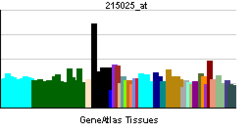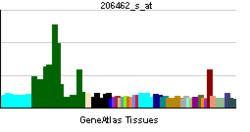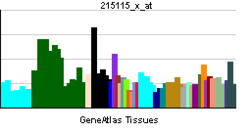- TrkC receptor
-
NT-3 growth factor receptor also known as neurotrophic tyrosine kinase receptor type 3 or TrkC tyrosine kinase or Trk-C receptor is a protein that in humans is encoded by the NTRK3 gene.[1]
TrkC is the high affinity catalytic receptor for the neurotrophin NT-3 (neurotrophin-3). As such, TrkC mediates the multiple effects of this neurotrophic factor, which includes neuronal differentiation and survival.
The TrkC receptor is part of the large family of receptor tyrosine kinases. A "tyrosine kinase" is an enzyme which is capable of adding a phosphate group to the certain tyrosines on target proteins, or "substrates". A receptor tyrosine kinase is a "tyrosine kinase" which is located at the cellular membrane, and is activated by binding of a ligand via its extracellular domain. Other example of tyrosine kinase receptors include the insulin receptor, the IGF-1 receptor, the MuSK protein receptor, the Vascular Endothelial Growth Factor (or VEGF) receptor, etc. The "substrate" proteins which are phosphorylated by TrkC include PI3 kinase.
Contents
Family Members
TrkC is part of a sub-family of protein kinases which includes TrkA and TrkB. Also, there are other neurotrophic factors structurally related to NT-3: NGF (for Nerve Growth Factor), BDNF (for Brain Derived Neurotrophic Factor) and NT-4 (for Neurotrophin-4). While TrkB mediates the effects of BDNF, NT-4 and NT-3, TrkA is bound and thereby activated only by NGF. Further, TrkC binds and is activated only by NT-3.
TrkB binds BDNF and NT-4 more strongly than it binds NT-3. TrkC binds NT-3 more strongly than TrkB does.
The LNGFR
There is one other NT-3 receptor family besides the Trks (TrkC & TrkB), called the "LNGFR" (for "low affinity nerve growth factor receptor"). As opposed to TrkC, the LNGFR plays a somewhat less clear role in NT-3 biology. Some researchers have shown the LNGFR binds and serves as a "sink" for neurotrophins. Cells which express both the LNGFR and the Trk receptors might therefore have a greater activity - since they have a higher "microconcentration" of the neurotrophin. It has also been shown, however, that the LNGFR may signal a cell to die via apoptosis - so therefore cells expressing the LNGFR in the absence of Trk receptors may die rather than live in the presence of a neurotrophin.
References
- ^ McGregor LM, Baylin SB, Griffin CA, Hawkins AL, Nelkin BD (July 1994). "Molecular cloning of the cDNA for human TrkC (NTRK3), chromosomal assignment, and evidence for a splice variant". Genomics 22 (2): 267–72. doi:10.1006/geno.1994.1383. PMID 7806211.
Further reading
- Lamballe F, Klein R, Barbacid M (1991). "trkC, a new member of the trk family of tyrosine protein kinases, is a receptor for neurotrophin-3". Cell 66 (5): 967–79. doi:10.1016/0092-8674(91)90442-2. PMID 1653651.
- Tessarollo L, Tsoulfas P, Martin-Zanca D, et al. (1993). "trkC, a receptor for neurotrophin-3, is widely expressed in the developing nervous system and in non-neuronal tissues". Development 118 (2): 463–75. PMID 8223273.
- Klein R, Silos-Santiago I, Smeyne RJ, et al. (1994). "Disruption of the neurotrophin-3 receptor gene trkC eliminates la muscle afferents and results in abnormal movements". Nature 368 (6468): 249–51. doi:10.1038/368249a0. PMID 8145824.
- Ip NY, Stitt TN, Tapley P, et al. (1993). "Similarities and differences in the way neurotrophins interact with the Trk receptors in neuronal and nonneuronal cells". Neuron 10 (2): 137–49. doi:10.1016/0896-6273(93)90306-C. PMID 7679912.
- Ebendal T (1992). "Function and evolution in the NGF family and its receptors.". J. Neurosci. Res. 32 (4): 461–70. doi:10.1002/jnr.490320402. PMID 1326636.
- Guiton M, Gunn-Moore FJ, Glass DJ, et al. (1995). "Naturally occurring tyrosine kinase inserts block high affinity binding of phospholipase C gamma and Shc to TrkC and neurotrophin-3 signaling.". J. Biol. Chem. 270 (35): 20384–90. doi:10.1074/jbc.270.35.20384. PMID 7657612.
- Shelton DL, Sutherland J, Gripp J, et al. (1995). "Human trks: molecular cloning, tissue distribution, and expression of extracellular domain immunoadhesins.". J. Neurosci. 15 (1 Pt 2): 477–91. PMID 7823156.
- Pflug BR, Dionne C, Kaplan DR, et al. (1995). "Expression of a Trk high affinity nerve growth factor receptor in the human prostate.". Endocrinology 136 (1): 262–8. doi:10.1210/en.136.1.262. PMID 7828539.
- Lamballe F, Tapley P, Barbacid M (1993). "trkC encodes multiple neurotrophin-3 receptors with distinct biological properties and substrate specificities.". Embo J. 12 (8): 3083–94. PMID 8344249.
- Andersson B, Wentland MA, Ricafrente JY, et al. (1996). "A "double adaptor" method for improved shotgun library construction.". Anal. Biochem. 236 (1): 107–13. doi:10.1006/abio.1996.0138. PMID 8619474.
- Yamamoto M, Sobue G, Yamamoto K, et al. (1997). "Expression of mRNAs for neurotrophic factors (NGF, BDNF, NT-3, and GDNF) and their receptors (p75NGFR, trkA, trkB, and trkC) in the adult human peripheral nervous system and nonneural tissues.". Neurochem. Res. 21 (8): 929–38. doi:10.1007/BF02532343. PMID 8895847.
- Yu W, Andersson B, Worley KC, et al. (1997). "Large-scale concatenation cDNA sequencing.". Genome Res. 7 (4): 353–8. doi:10.1101/gr.7.4.353. PMC 139146. PMID 9110174. http://www.pubmedcentral.nih.gov/articlerender.fcgi?tool=pmcentrez&artid=139146.
- Valent A, Danglot G, Bernheim A (1997). "Mapping of the tyrosine kinase receptors trkA (NTRK1), trkB (NTRK2) and trkC(NTRK3) to human chromosomes 1q22, 9q22 and 15q25 by fluorescence in situ hybridization.". Eur. J. Hum. Genet. 5 (2): 102–4. PMID 9195161.
- Terenghi G, Mann D, Kopelman PG, Anand P (1997). "trkA and trkC expression is increased in human diabetic skin.". Neurosci. Lett. 228 (1): 33–6. doi:10.1016/S0304-3940(97)00350-9. PMID 9197281.
- Knezevich SR, McFadden DE, Tao W, et al. (1998). "A novel ETV6-NTRK3 gene fusion in congenital fibrosarcoma.". Nat. Genet. 18 (2): 184–7. doi:10.1038/ng0298-184. PMID 9462753.
- Urfer R, Tsoulfas P, O'Connell L, et al. (1998). "High resolution mapping of the binding site of TrkA for nerve growth factor and TrkC for neurotrophin-3 on the second immunoglobulin-like domain of the Trk receptors.". J. Biol. Chem. 273 (10): 5829–40. doi:10.1074/jbc.273.10.5829. PMID 9488719.
- Hu YQ, Koo PH (1998). "Inhibition of phosphorylation of TrkB and TrkC and their signal transduction by alpha2-macroglobulin.". J. Neurochem. 71 (1): 213–20. PMID 9648868.
- Ichaso N, Rodriguez RE, Martin-Zanca D, Gonzalez-Sarmiento R (1998). "Genomic characterization of the human trkC gene.". Oncogene 17 (14): 1871–5. doi:10.1038/sj.onc.1202100. PMID 9778053.
- Qian X, Riccio A, Zhang Y, Ginty DD (1999). "Identification and characterization of novel substrates of Trk receptors in developing neurons.". Neuron 21 (5): 1017–29. doi:10.1016/S0896-6273(00)80620-0. PMID 9856458.
- Bibel M, Hoppe E, Barde YA (1999). "Biochemical and functional interactions between the neurotrophin receptors trk and p75NTR.". Embo J. 18 (3): 616–22. doi:10.1093/emboj/18.3.616. PMC 1171154. PMID 9927421. http://www.pubmedcentral.nih.gov/articlerender.fcgi?tool=pmcentrez&artid=1171154.
- Labouyrie E, Dubus P, Groppi A, et al. (1999). "Expression of neurotrophins and their receptors in human bone marrow.". Am. J. Pathol. 154 (2): 405–15. PMID 10027399.
PDB gallery Protein kinases: tyrosine kinases (EC 2.7.10) Receptor tyrosine kinases (EC 2.7.10.1) Insulin receptor familyPDGF receptor familyFGF receptor familyVEGF receptors familyHGF receptor familyTrk receptor familyEPH receptor familyLTK receptor familyLTK · ALKTIE receptor familyROR receptor familyROR1 · ROR2DDR receptor familyPTK7 receptor familyRYK receptor familyMuSK receptor familyROS receptor familyAATYK receptor familyAXL receptor familyRET receptor familyuncatagorisedNon-receptor tyrosine kinases (EC 2.7.10.2) ABL familyACK familyACK1 · TNK1CSK familyFAK familyFES familyFRK familyJAK familySRC-A familySRC-B familyTEC familySYK familyTransmembrane receptor, tyrosine kinase: receptor tyrosine kinases (EC 2.7.10.1) I: EGF/ErbB II III: PDGF IV: FGF V: VEGF VII: TRK VIII: Eph XI: Angiopoietin Other Receptors: growth factor receptors Type I cytokine receptor Receptor protein serine/threonine kinase Receptor tyrosine kinase Fibroblast growth factor (1, 2, 3, 4)
Nerve growth factors: high affinity Trk (TrkA, TrkB, TrkC)
Somatomedin (Insulin-like growth factor 1)
VEGF (1, 2, 3)Tumor necrosis factor receptor Ig superfamily Other/ungrouped Categories:- Human proteins
- Developmental neuroscience
- Programmed cell death
- Tyrosine kinase receptors
- Chromosome 15 gene stubs
Wikimedia Foundation. 2010.





